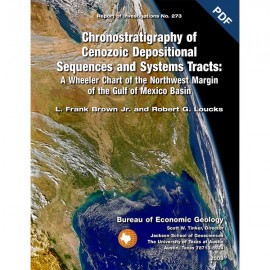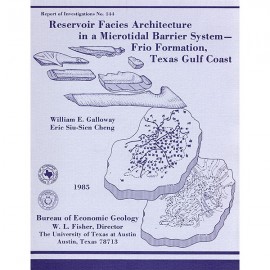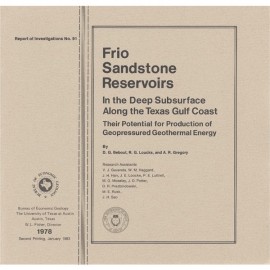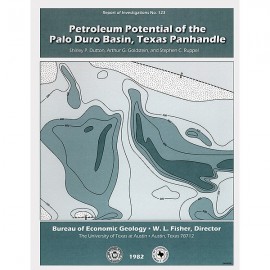Reports of Investigations
-
Books & Reports
- Reports of Investigations
- Guidebooks
- Udden Series
- Geological Circulars
- Down To Earth
- Atlases of Major Oil and Gas Reservoirs
- Texas Memorial Museum Publications
- Environmental Geologic Atlas of the Texas Coastal Zone
- Mineral Resource Circulars
- Other Reports
- Seminars and Workshops
- Handbooks
- Submerged Lands of Texas
- Symposia
- Annual Reports
- Open File Reports
-
Maps & Cross Sections
- Thematic Maps
- Miscellaneous Maps, Charts & Sections
- Geologic Atlas of Texas
- STATEMAP Project Maps
- Geologic Quadrangle Maps
- Cross Sections
- Highway Geology Map
- Energy and Mineral Resource Maps
- Shoreline Change and Other Posters
- Wilcox Group, East Texas, Geological / Hydrological Folios
- Bouguer Gravity Atlas of Texas
- River Basin Regional Studies
- Featured Maps
- Posters
- Teachers & the Public
-
Geological Society Publications
- Gulf Coast Association of Geological Societies
- Alabama Geological Society
- Austin Geological Society
- Corpus Christi Geological Society
- Houston Geological Society
- Lafayette Geological Society
- Mississippi Geological Society
- New Orleans Geological Society
- South Texas Geological Society
- GCS SEPM Publications
- Historic BEG & UT Series
Smackover and Lower Buckner Formations, Jurassic, South Texas: Depositional Systems
RI0112
Smackover and Lower Buckner Formations South Texas: Depositional Systems on a Jurassic Carbonate Ramp, by D. A. Budd and R. G. Loucks. 38 p., 26 figs., 3 tables, 1981. ISSN: 0082335X: Print Version.
A free, digital version of this publication can be found on: Texas ScholarWorks
RI0112. Smackover and Lower Buckner Formations South Texas: Depositional Systems on a Jurassic Carbonate Ramp, by D. A. Budd and R. G. Loucks. 38 p., 26 figs., 3 tables, 1981. ISSN: 0082335X: Print.
To purchase this publication as a downloadable PDF, please order RI0112D.
ABSTRACT
The Smackover and lower part of the Buckner Formations (Oxfordian) comprise a thick regressive sedimentary sequence deposited on a Jurassic carbonate ramp. Four major depositional systems are recognized: (1) basinal, (2) low-energy open shelf, (3) high-energy shoal, and (4) sabkha. Lithofacies boundaries within each system and between systems follow paleobathymetrical contours. High-energy grainstone facies were concentrated landward; muddy low-energy facies were deposited seaward.
Basinal facies are dominated by laminated carbonate mudstones, deposited from suspension, and irregularly laminated carbonate mudstones, the product of sediment reworking by oscillatory bottom currents. The outer-shelf facies is characterized by burrowed carbonate mudstones containing crustacean pellets and a pelagic fauna. The inner-shelf facies is composed of burrowed wackestones containing a benthic fauna. Burrowed oncolite and pellet packstones characterize the outer-shoal system, and crossbedded mixed-allochem, oolite-intraclast, and oolite grainstones compose the high-energy inner shoal system. Increased sorting and decreased grain size within these facies suggest increasing energy levels landward even within the shoal system.
The sabkha system consists of cyclic subtidal to supratidal facies. Subtidal units are represented by burrowed gastropod and pellet wackestones and oolite wackestones to grainstones, whereas the intertidal zone is characterized by cross-laminated sandstones and algal-laminated dolomite mudstones. The supratidal facies consists of anhydrite nodules intercalated with carbonate and terrigenous mud, and siliciclastic sand and silt.
Depositional systems of the Yucatan Shelf of the Gulf of Mexico may be an approximate analogue for those of the Smackover Formation. Smackover moderate-energy packstones may have originated in stabilized grainflats, whereas Smackover grainstones were deposited in mobile sand waves, shoals, spits, spillover lobes, beaches, and eolian dunes. Depositional environments of the Trucial Coast of the Persian Gulf are in part analogous to the Buckner sabkha system. Subtidal units of the lower part of the Buckner Formation were deposited in coastal lagoons, tidal-channel deltas, spits, and beaches. Intertidal facies include sediment deposited in sand flats and algal mat zones. Supratidal facies are characterized by anhydrite nodules.
CONTENTS
ABSTRACT
INTRODUCTION
PURPOSE
METHODS
REGIONAL GEOLOGIC SETTING
STRATIGRAPHIC FRAMEWORK
STRUCTURAL FRAMEWORK
FACIES AND DEPOSITIONAL SYSTEMS
BASINAL SYSTEM
Deep basin
Shallow basin
LOW-ENERGY CARBONATE SHELF SYSTEM
Outer shelf
Inner shelf
HIGH-ENERGY SHOAL SYSTEM
Outer shoal
Inner shoal
Pellet grainstone
Mixed-allochem grainstones
Oolitic quartzarenite
Intraclast, oolite-intraclast, and oolite grainstones
SABKHA SYSTEM
Subtidal
Intertidal
Supratidal
DEPOSITIONAL MODEL
MODERN ANALOGS
Yucatan Shelf
Trucial Coast, Persian Gulf
SMACKOVER MODEL
BASIN EVOLUTION
CONCLUSIONS
ACKNOWLEDGMENTS
REFERENCES
APPENDIX: SOUTH TEXAS SMACKOVER AND BUCKNER WELLS
FIGURES
1. Index map of South Texas study area showing wells that penetrate the Buckner and Smackover Formations
2. Generalized Jurassic stratigraphic nomenclature, Texas Gulf Coast
3. Coastal onlap of Jurassic strata, South Texas
4. Regional dip section A-A', Upper Jurassic strata, South Texas
5. Distinguishing characteristics, lithic composition, and generalized depositional environments of Jurassic strata, northern Gulf Coast Basin
6. Facies map of Smackover Formation, northern Gulf Coast Basin
7. Structural framework, northern Gulf Coast Basin
8. Idealized vertical sequence of Smackover and lower Buckner depositional systems and component facies
9. Interpreted Smackover depositional systems of dip section A-A', South Texas
10. Vertical sequences of lithology, structures, constituents, and fauna within basinal and shelf systems, Smackover Formation
11. Facies and bedding features, basinal system
12. Facies, structures, and characteristic features, shelf system
13. Vertical sequences of lithology, structures, constituents, and fauna within the high-energy shoal system, Smackover Formation
14. Textures and allochems of oncolite and pellet facies
15. Bedding structures of fine-grained oolitic quartzarenite
16. Oolite and intraclast grainstones, high-energy inner shoal
17. Postulated axis of maximum buildup, high-energy Smackover shoal system
18. Vertical sequences of subtidal to supratidal deposits, Buckner sabkha system
19. Subtidal facies and structures, Buckner sabkha system
20. Intertidal facies and structures, Buckner sabkha system
21. Anhydrite textures of supratidal facies, Buckner sabkha system
22. Profile of modern western Yucatan Shelf and facies map of relict Holocene sediment, Yucatan Shelf: modern ramp analogs
23. Facies map, high-energy grainstones, eastern Yucatan Shelf
24. Bathymetric profile, facies sequence, and schematic map of the Trucial Coast, Persian Gulf: modern sabkha analog
25. Depositional model, Smackover and lower Buckner depositional systems, South Texas
26. Interpreted evolution of deposition in the Smackover basin
TABLES
1. Smackover facies and characteristics
2. Lower Buckner facies and characteristics
3. Comparison of the ramp and rimmed shelf models of modern carbonate environments
Keywords: Smackover Formation, Buckner Formation, Jurassic, carbonate, sabkha system, facies, Texas
Citation
Budd, D. A., and Loucks, R. G., 1981, Smackover and Lower Buckner Formations South Texas: Depositional Systems on a Jurassic Carbonate Ramp: The University of Texas at Austin, Bureau of Economic Geology, Report of Investigations No. 112, 38 p.






